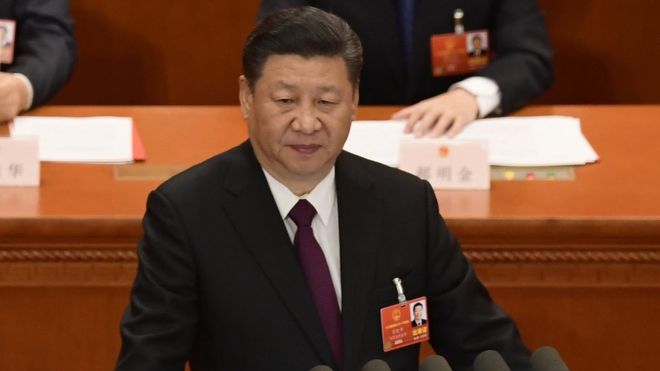Geneva, 6 Apr (D. Ravi Kanth) – In a robust response to US President Donald Trump’s latest threat that he would consider slapping tariffs on an additional $100 billion on imports of Chinese goods, Beijing said it would impose “comprehensive countermeasures” on US goods if President Trump goes ahead with his latest threat.A spokesperson for China’s ministry of commerce said Friday (6 April) that China would take “comprehensive countermeasures” to counter US protectionism “to the end and at any cost.”
“The Chinese side will follow suit to the end and at any cost, and will firmly attack, using new comprehensive countermeasures, to firmly defend the interest of the nation and its people,” the ministry of commerce said in a statement on its website.
“China does not want a trade war, but we’re not afraid to fight a trade war,” the Chinese commerce spokesperson said.
“We will accompany [the US] until the end, we will not hesitate in paying any price,” said Lu Kan, China’s foreign ministry spokesperson, on Friday.
On Wednesday (4 April), China signalled that it would impose additional duty of 25% on about US$50 billion of American goods, specifying politically-sensitive (to Trump supporters or areas of the country that voted for him) agricultural items such as soybeans, and other items like aircraft, automobiles, and chemicals .
This was in response to the USTR’s decision to impose additional duties on Chinese goods worth US$50 billion, purporting to act on Beijing’s alleged continued IPR violations, as unilaterally determined by the US under Section 301 of its trade laws.
Subsequently, senior officials from the US and China held meetings to contain the worsening tit-for-tat trade war.
President Trump’s new chief economic advisor Larry Kudlow played down the prospect of a trade war, informing Fox News that “we are going to come to agreements.”
He suggested that “the Chinese will back down and will play ball.”
But on Thursday (5 April), President Trump intensified the war of words, threatening that he would slap additional duties to the tune of US$100 bill ion, trebling the total to US$150 billion.
“In the light of China’s unfair retaliation, I have instructed USTR to consider whether $100 billion of additional tariffs would be appropriate,” he said.
According to a report in Washington Trade Daily on Friday (6 April), the USTR’s office “which earlier this week had released a list of Chinese products that could be subject to $50 billion in additional tariffs originally proposed by the President – now will propose a new list of additional products to target.”
Notwithstanding his continued threats, President Trump also said cautiously that he is prepared to have discussions with the Chinese on “free, fair and reciprocal trade and to protect the technology and intellectual property of American companies and American people.”
“You have to go after the people who aren’t treating you right,” President Trump said in West Virginia on Thursday.
“We’re going to have a fantastic relationship long term with China, but we have to get straightened out. We have to have some balance,” he said in West Virginia.
In short, President Trump, who is being attacked by his own party heavyweights from Iowa and other states, is unable to contain his bellicose threats.
“Hopefully, the President is just blowing off steam again but, if he’s even half serious, this is nuts,” said a Republican Senator, according to a report in “The Hill” on Thursday.
“China is guilty of many things, but the President has no actual plan to win right now,” Republican Senator Ben Sasse said.
“He’s [President Trump] threatening to light American agriculture on fire. Let’s absolutely take on Chinese bad behaviour, but with a plan that punishes the m instead of us. This is the dumbest possible way to do this,” said Senator Sasse.
China’s measured responses to the growing unilateral threats from Trump is an opportunity for all countries to rally around China to face the new dynamic in global trade, said a senior United Nations official, who asked not to be quoted.
“It is unforgivable that the dominant western countries – the European Union, Japan, Canada, and others – who preached about free trade are remaining silent at a time when they are required to resist the threats posed to the multilateral trading system,” the official said.
[President Trump’s actions and announcements (of levies citing national security on imports of steel and aluminium, and other tariffs purporting to act under S.301 over Chinese “unfair trade practices”) has evoked a lively discussion among US trade lawyers and trade law academics, with several of them posting comment s at the IELP blog run by Prof Simon Lester. Among the comments is one by Prof Steve Charnovitz, who has argued that GATT Art. XXI cannot provide justification for S.232 tariffs, whose sole purpose is to protect domestic production. He does not also consider “safeguards” action as useful, since it is time-limited. Instead, he has suggested that Trump should have opted for ta riff modifications under GATT Art. XXVIII. It is not clear though from posts and comments, how this could have been used to raise tariffs on Chinese imports alone, without also doing so from others. SUNS]
Meanwhile, China launched dispute settlement proceedings against the US on Wednesday, challenging Washington’s Section 301 investigations against Chin a and the proposed additional duties of 25% on a list of Chinese products (that) violate global trade rules.
In a tit-for-tat response to the US dispute against China’s alleged violation of intellectual property provisions last week, China simultaneously announced additional duties to the tune of $50 billion on American products and followed it up with raising a strong legal dispute at the WTO.
China has called on the US to enter into Article 4 consultations as per the Dispute Settlement Understanding to address its specific complaints, particularly the proposed duties that would be only applied to China’s products and in excess of the United States’ bound rates in its Schedule of Concessions and Commitments annexed to the GATT 1994.
China also challenged the specific legal provisions set out in Section 301- 310 of the Trade Act of 1974. It questioned the legal basis for “findings of the investigation into China’s acts, policies and practices related to technology transfer, intellectual property and innovation under Section 301 of the Trade Act of 1974, dated 22 March 2018.”
China said “actions by the United States Related to the Section 301 Investigation of China’s Laws, Policies, Practices, or Actions Related to Technology Transfer, Intellectual Property, and Innovation, dated 22 March 2018” violate core WT O provisions.
China said that “the US measures appear to be inconsistent with the relevant provisions of the WTO covered agreements.”
China said the US actions are inconsistent with the following provisions:
1. Article I.1 of the GATT 1994, because the measures at issue fail to extend immediately and unconditionally to China an “advantage, favour, privilege o r immunity” granted by the United States “[w]ith respect to customs duties an d charges of any kind imposed on or in connection with” the importation of products originating in the territory of other Members.
2. Article II.1(a) and (b) of the GATT 1994, because the measures at issue fail to accord to the products originating in China identified in the above mentioned documents the treatment no less favourable than that provided for in the United States’ Schedule of Concessions and Commitments annexed to the GATT 1994.
3. Article 23 of the DSU, because the measures at issue fail to have recourse to, and abide by, the rules and procedures of the DSU, when the United States s eek the redress of a violation of obligation or other nullification or impairment of benefits under the covered agreements or an impediment to the attainment of any objective of the covered agreements.
China said “as a consequence of the foregoing, the measures at issue appear to nullify or impair benefits accruing to China directly or indirectly under t he cited agreements.”
In short, China’s ability to respond to the spate of unilateral threats followed by measures by the dominant trade hegemon is a defining moment in the emerging global trade architecture.
Several trade observers felt that the countries of the South ought to rally around Beijing to ensure that unilateral threats have no place in the WTO system.
In some ways, the current face-off between China and the US appears like the situation that prevailed prior to the Second World War.- Third World Network




